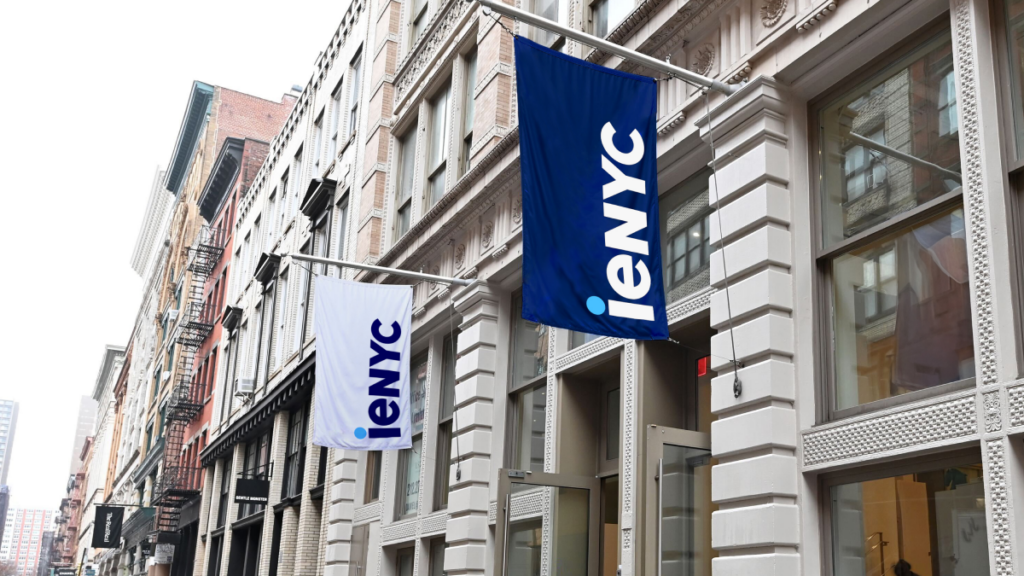Studying in SoHo is a unique and enviable experience. IENYC’s campus is smack dab in the middle of it. Discover the rich history and culture of the chic neighborhood in Lower Manhattan.
Designated as a historic district of New York in 1973, its artsy vibe and industrial heritage have blended to shape modern SoHo as an unlikely mix of cast-iron architecture, loft living and upscale shopping boutiques. In fact, the “SoHo effect” has become a byword in The Big Apple for repurposing an industrial district for mixed commercial and residential use while preserving the existing architecture. It’s one of the coolest neighborhoods in New York—and it’s IENYC’s home.
From textiles through fashion and art to high-end shopping, SoHo is an area of Manhattan with a richly varied history. Its name comes from “South of Houston Street,” and these days you’ll find impressive buildings, fantastic luxury shopping, outdoor markets, excellent restaurants, art galleries and even an ice cream museum in the neighborhood. As a home for life and study, it’s one of the best places in one of the best cities in the world.
Checkered history has made its mark
To understand why SoHo is so eclectic and diverse now, we can take a look into its history. Going back to the 18th century, the area was still green and was used for recreation. But New York City was growing fast at this time, and by the early nineteenth century, SoHo had already become a commercial destination for some of the city’s better-off residents. Tiffany’s opened their first store on Broadway, for example, just a few blocks from where IENYC is now.
It was a center for New Yorkers to find entertainment until around the 1850s. By 1870, SoHo was dubbed the Cast Iron District—a nickname that sticks even today—due to the distinctive facades of the buildings in the area. From around this time until the middle of the 20th century, the neighborhood was the center of New York’s textile industry, too. In fact, the term “rag trade” comes from the businesses which collected scraps of fabric, sorted them by fibers, and sent them on to be recycled.
The changing face of SoHo
From the 1950s, artists began to move in, drawn to SoHo by the large open spaces and lofts of its industrial-era buildings, which offered low-cost living and ample natural light. By the 1970s, many of New York’s most prominent artists were displaying their work in galleries in the area, and a tight-knit community had developed.
By the 1990s, the neighborhood’s increasing desirability saw some of the art galleries move out as rents rose. New businesses came; high-end shopping boutiques, restaurants, bars and nightclubs. Today, even Tiffany’s is back after nearly two hundred years, and SoHo is now one of New York’s most sought-after areas to live, work and study.
One of New York’s hippest neighborhoods
SoHo’s appeal is understandable. There’s great diversity of people, business and character in the neighborhood. Some of the highlights include:
Art galleries: A nod to SoHo’s artistic heritage and typical of its character, there are still plenty of amazing art galleries around. The New York Earth Room, the Drawing Center and the Leslie-Lohman Museum of Gay and Lesbian Art are all in the area, to name just a few of the spaces that showcase the huge diversity and talent to be found in SoHo.
Museums: If museums are your thing, there are plenty nearby to wile away your free time. The Museum of Ice Cream is great fun, as is the highly interactive Color Factory, while the Museum of Chinese in America explores the history, culture and heritage of people of Chinese descent in the United States.
Vibrant food scene: A diverse mix of cafes, upscale restaurants and laid-back eateries can be found in the area, catering to a variety of tastes and budgets. The iconic French restaurant, Balthazar, is just a few blocks from IENYC, and you’ll also find a range of bakeries and brunch spots alongside other numerous international offerings.
Shopping: If you love a bit of retail therapy, SoHo is your utopia, with some of the world’s top brands in fashion, luxury goods and other retail sectors on your doorstep.
Canal Street Market: A great space for food, socializing and community activities. Open year-round, it’s a bustling spot that’s perfect for meeting people and supporting small businesses.
Proud to call SoHo home
IENYC is located on the historic Wooster Street, which has often been used as a film set, providing a backdrop of cobblestones and flagstoned sidewalks. One of our neighboring buildings has even been called “the birthplace of SoHo,” so we’re right in the heart of things.

Granted a charter by the New York State Education Department to award master’s degrees in business, our mission remains to teach a business curriculum in pursuit of the Common Good and the UN SDGs behind the intricately carved facade of our 125-year-old building.
Ready to live and study in an iconic New York neighborhood? Get exploring!